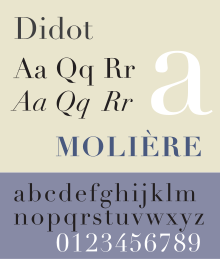Didot (font)

|
|
| font | Antiqua |
| category | Serif |
| Font family | Didot Antiqua |
| Font classification | classical antiqua |
| Font designer | François Didot , further development Firmin Didot , Pierre Didot |
| publication | 1788
around 1800 D. Stempel AG , Frankfurt / M. by taking over a type foundry; |
| Republish | Reinterpretation by Adrian Frutiger for Linotype |
| example | |

|
|
The Didot is a typical classical Antiqua -Font. The first drafts come from François Didot (1689–1757), the grandsons Firmin Didot and his brother Pierre Didot developed the font further. The Didot Antiqua was first cast in 1788.
The Didot Antiqua, cast by H. Berthold AG, is based on Pierre Didot's designs.
The Didot shows the differences in stroke width typical of classicism . The applied serifs are finer than the classic Bodoni and Walbaum published in 1800 .
use
The Diogenes Verlag used Didot in the design of its unified book covers .
Web links
Commons : Didot (font) - collection of images, videos and audio files
- Theano Didot, free implementation by Alexey Kryukov, published under the SIL Open Font License (OFL)
Individual evidence
- ↑ Klingspor Museum Offenbach: International directory of metal type fonts compiled by Hans Reichardt, manuscript. Library Klingspor Museum, 2011, Frankfurt / Main, p. 101
- ↑ Abraham Horodisch : The writing in the beautiful book of our time, 1931, Berlin, p. 5
- ^ Albrecht Seemann (Ed.): Handbook of Fonts, Albrecht Seemann Verlag, 1926, Leipzig, p. 79
- ↑ Michael Schikowski: Shine and Melancholy - The Diogenes Book. Diogenes Verlag , February 16, 2015, accessed on August 14, 2020 .